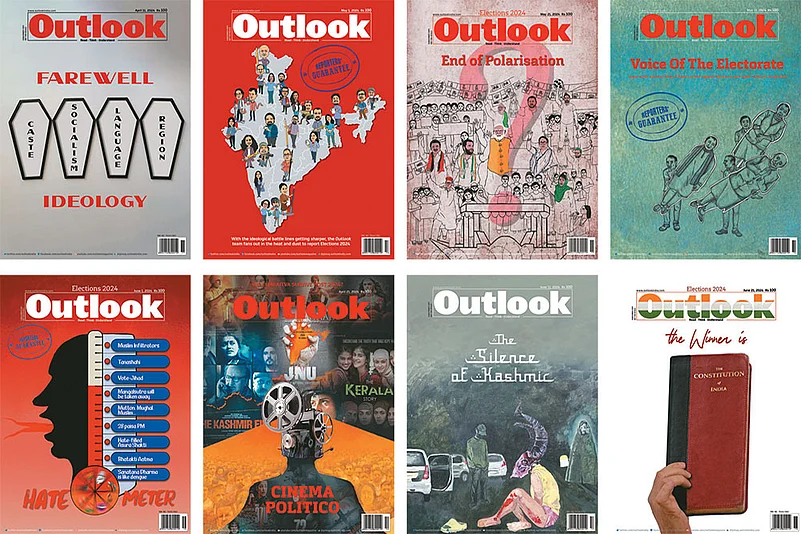Outlook magazine started its election coverage with an issue dedicated to the exploration of the different ideologies of various political parties and how they have expanded, changed or even diffused over the years to hold many contradictions resulting from the diversity of the country in terms of caste, colour, religion and class. Voters are known to vote for parties that echo their own ideological viewpoints.
In the recent elections, we witnessed a battle of ideologies. The people gave a mixed verdict. Hindutva as an ideology hasn’t been rejected completely. Other ideologies have also been voted in. Information and misinformation were both in abundance in the digital wipeout age. Coalition politics is back. Arrogance has been punished.
At Outlook, we decided to close our election coverage with an issue that is a summary of what happened.
The little red book, a version of the Constitution of India, became a symbol of the pushback from the people.
This led us to contemplate the cover image for this issue.
The image on the cover is a replication of a library made of paper and cardboard, by architect and artist Dia Mehhta Bhupal. It is empty, with two unoccupied chairs. There is an absence. There is also a presence of books in a space we are accustomed to, but perhaps do not engage with, in the digital age.
A library is a political space that has resisted supermarket sheen and gloss. The monopolistic power of big supermarkets perpetuates wealth inequality and social and political isolation, the two big challenges of our time.
A library, presented like this, is also a topography of absence, as the artist says.
Libraries cross curricular lines. In times where syllabus changes are being made to promote a specific set of ideologies, an altered version of history, a selective interpretation and representation of facts and beliefs and people, libraries are even more important because of their commitment to inclusivity, to resist social and political isolation. A public library is a resistive space and a space for the preservation of different ideological frameworks and their relevance in political life.
Books are a tangible experience. A library isn’t a fleeting space. We have seen our own bookshelves transform, become splashy and perhaps the title itself speaks about the life and times of the book covers, which once had an element of art, but have now become solicitors in garish costumes against the night sky. To stand out, to be bought, to survive. Like the night walkers.
Bhupal uses paper as her medium to make the ordinary seem a little extraordinary. Familiar and yet, strange. Libraries are those spaces now. It is a reminder that libraries are fast becoming obsolete because of the “changing use” pattern ushered in by the digital shift, which has also led to an information gap, fake news, and reconstructed and repurposed histories.
A public library is a democratic space that challenges existing power dynamics by providing equal access to knowledge.
It is a place for congregations of readers, ideas, stories and visitors. The internet can’t replicate the sense of a place.
A public library unites.
The cover features what we take for granted, the spaces that go unnoticed. It is in these spaces that ideas live.
Ideology is for the library, said a politician recently.
But the library is for the people. Like democracy. Like ideologies.
(This appeared in the print as 'Library Is For The Public')

















